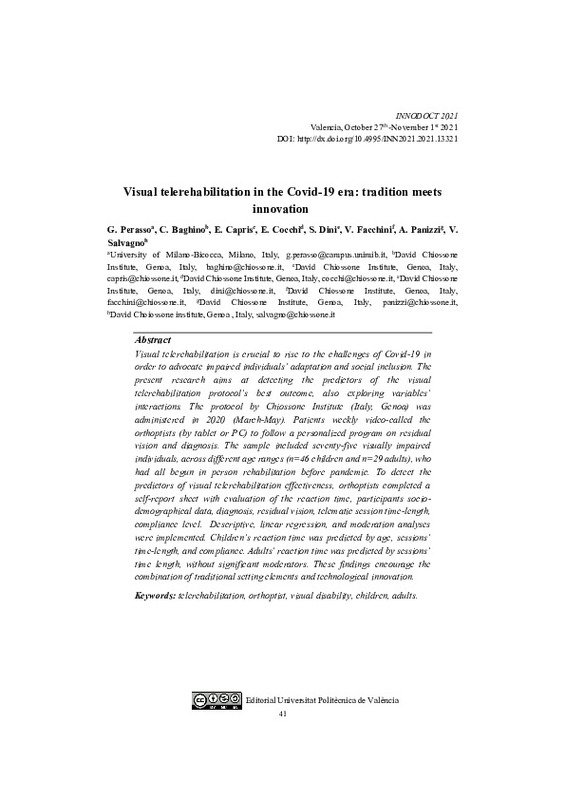JavaScript is disabled for your browser. Some features of this site may not work without it.
Buscar en RiuNet
Listar
Mi cuenta
Estadísticas
Ayuda RiuNet
Admin. UPV
Visual telerehabilitation in the Covid-19 era: tradition meets innovation
Mostrar el registro sencillo del ítem
Ficheros en el ítem
| dc.contributor.author | Perasso, Giulia
|
es_ES |
| dc.contributor.author | Baghino, Chiara
|
es_ES |
| dc.contributor.author | Capris, Elisabetta
|
es_ES |
| dc.contributor.author | Cocchi, Elena
|
es_ES |
| dc.contributor.author | Dini, Silvia
|
es_ES |
| dc.contributor.author | Facchini, Valentina
|
es_ES |
| dc.contributor.author | Panizzi, Antonella
|
es_ES |
| dc.contributor.author | Salvagno, Valentina
|
es_ES |
| dc.date.accessioned | 2022-10-25T10:39:25Z | |
| dc.date.available | 2022-10-25T10:39:25Z | |
| dc.date.issued | 2022-01-19 | |
| dc.identifier.isbn | 9788490483657 | |
| dc.identifier.uri | http://hdl.handle.net/10251/188671 | |
| dc.description.abstract | [EN] Visual telerehabilitation is crucial to rise to the challenges of Covid-19 in order to advocate impaired individuals’ adaptation and social inclusion. The present research aims at detecting the predictors of the visual telerehabilitation protocol’s best outcome, also exploring variables’ interactions. The protocol by Chiossone Institute (Italy, Genoa) was administered in 2020 (March-May). Patients weekly video-called the orthoptists (by tablet or PC) to follow a personalized program on residual vision and diagnosis. The sample included seventy-five visually impaired individuals, across different age ranges (n=46 children and n=29 adults), who had all begun in person rehabilitation before pandemic. To detect the predictors of visual telerehabilitation effectiveness, orthoptists completed a self-report sheet with evaluation of the reaction time, participants socio-demographical data, diagnosis, residual vision, telematic session time-length, compliance level. Descriptive, linear regression, and moderation analyses were implemented. Children’s reaction time was predicted by age, sessions’ time-length, and compliance. Adults’ reaction time was predicted by sessions’ time length, without significant moderators. These findings encourage the combination of traditional setting elements and technological innovation. | es_ES |
| dc.format.extent | 8 | es_ES |
| dc.language | Inglés | es_ES |
| dc.publisher | Editorial Universitat Politècnica de València | es_ES |
| dc.relation.ispartof | Proceedings INNODOCT/21. International Conference on Innovation, Documentation and Education | |
| dc.rights | Reconocimiento - No comercial - Compartir igual (by-nc-sa) | es_ES |
| dc.subject | Telerehabilitation | es_ES |
| dc.subject | Orthoptist | es_ES |
| dc.subject | Visual disability | es_ES |
| dc.subject | Children | es_ES |
| dc.subject | Adults | es_ES |
| dc.subject | ICT | es_ES |
| dc.title | Visual telerehabilitation in the Covid-19 era: tradition meets innovation | es_ES |
| dc.type | Capítulo de libro | es_ES |
| dc.type | Comunicación en congreso | es_ES |
| dc.identifier.doi | 10.4995/INN2021.2021.13321 | |
| dc.rights.accessRights | Abierto | es_ES |
| dc.description.bibliographicCitation | Perasso, G.; Baghino, C.; Capris, E.; Cocchi, E.; Dini, S.; Facchini, V.; Panizzi, A.... (2022). Visual telerehabilitation in the Covid-19 era: tradition meets innovation. En Proceedings INNODOCT/21. International Conference on Innovation, Documentation and Education. Editorial Universitat Politècnica de València. 41-48. https://doi.org/10.4995/INN2021.2021.13321 | es_ES |
| dc.description.accrualMethod | OCS | es_ES |
| dc.relation.conferencename | INNODOCT 2021 | es_ES |
| dc.relation.conferencedate | Octubre 27-Noviembre 01, 2021 | es_ES |
| dc.relation.conferenceplace | Valencia, España | es_ES |
| dc.relation.publisherversion | http://ocs.editorial.upv.es/index.php/INNODOCT/INN2021/paper/view/13321 | es_ES |
| dc.description.upvformatpinicio | 41 | es_ES |
| dc.description.upvformatpfin | 48 | es_ES |
| dc.type.version | info:eu-repo/semantics/publishedVersion | es_ES |
| dc.relation.pasarela | OCS\13321 | es_ES |








